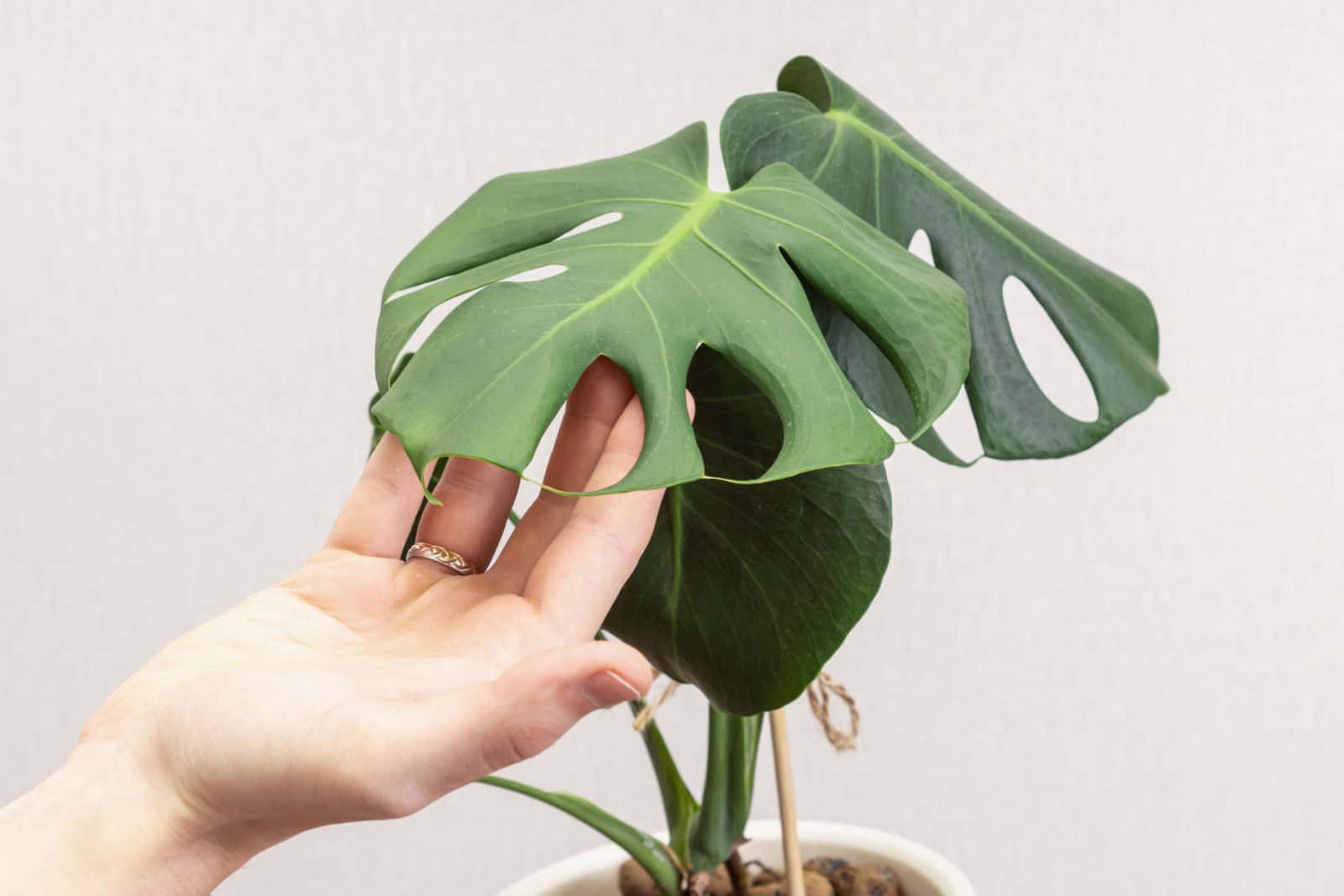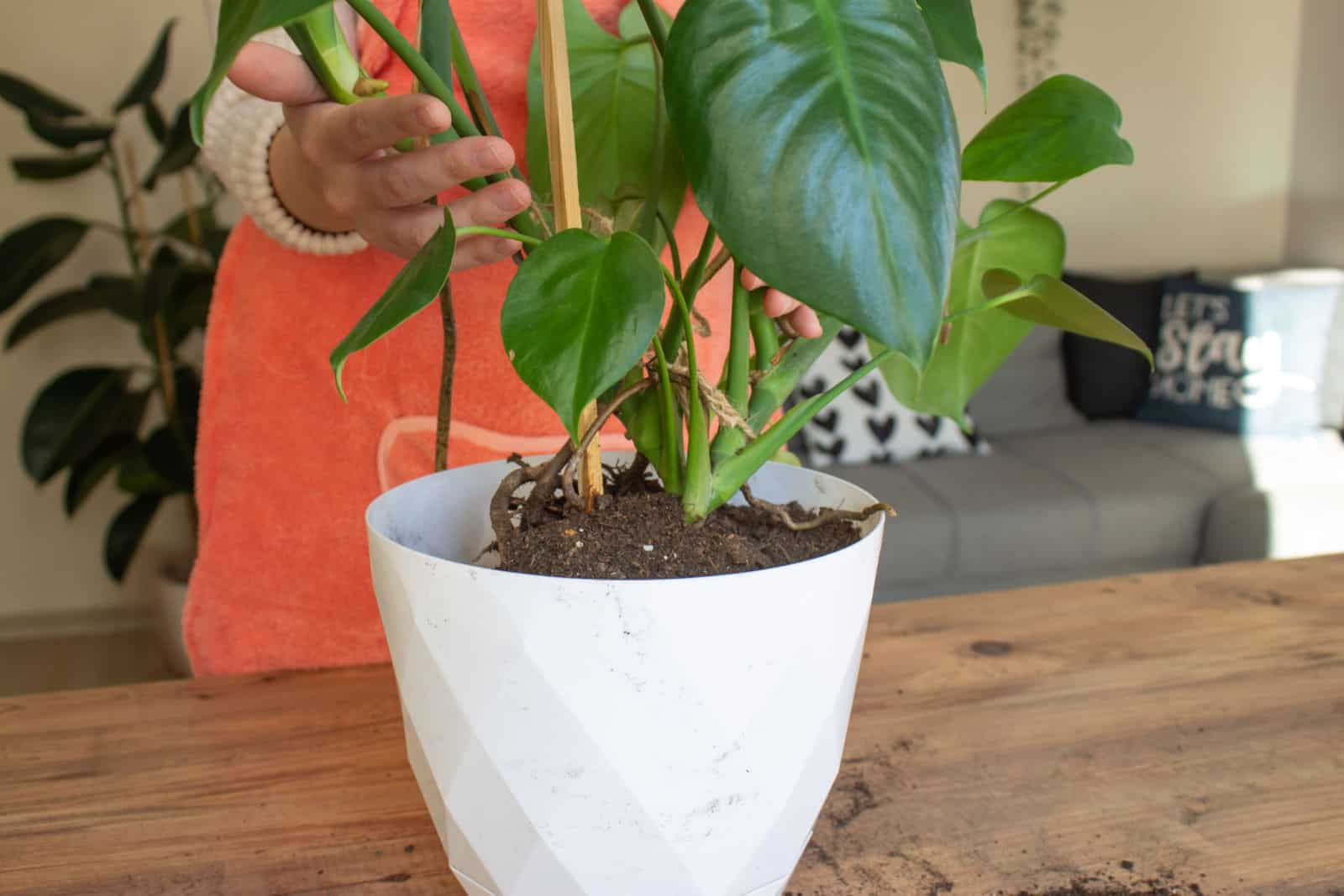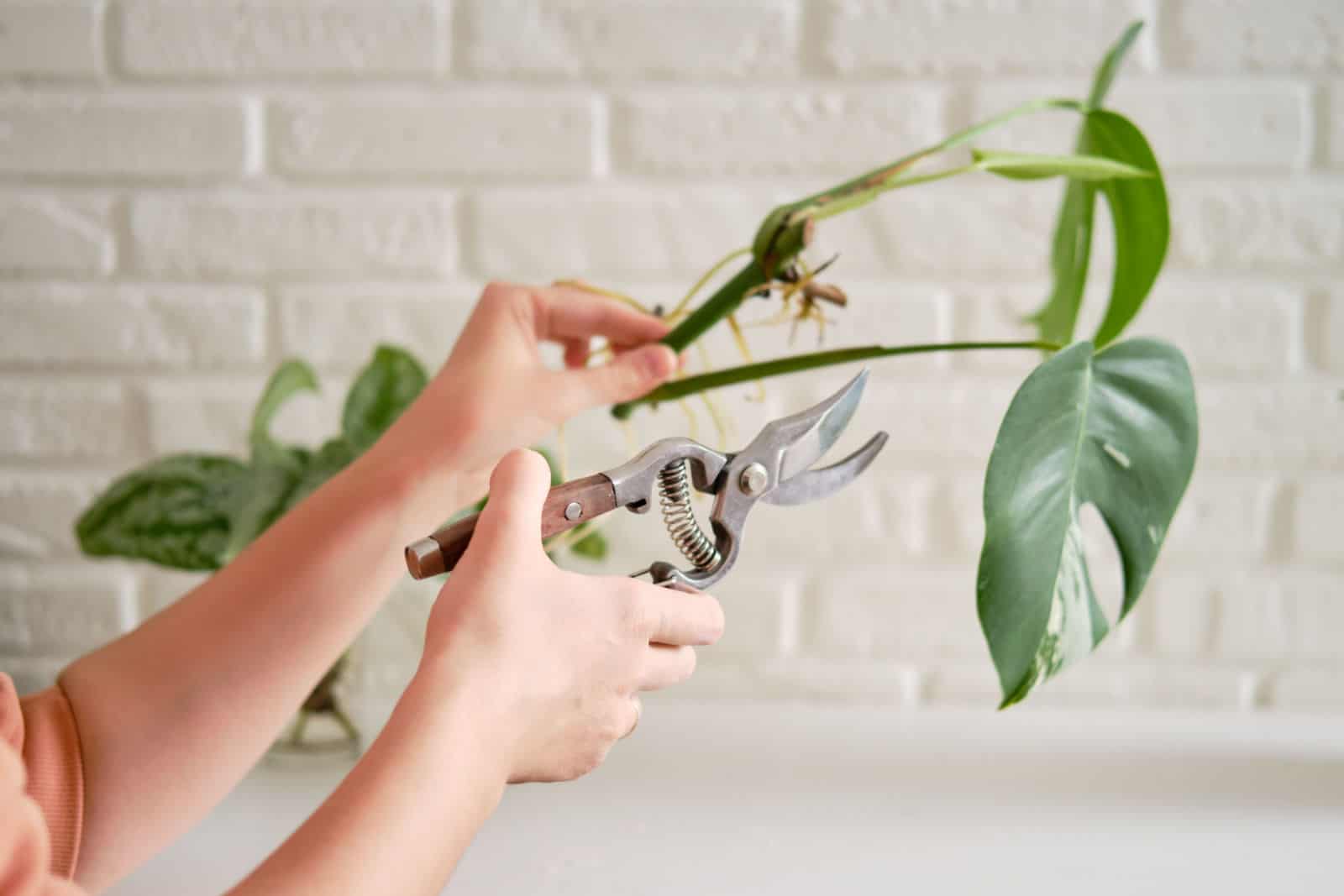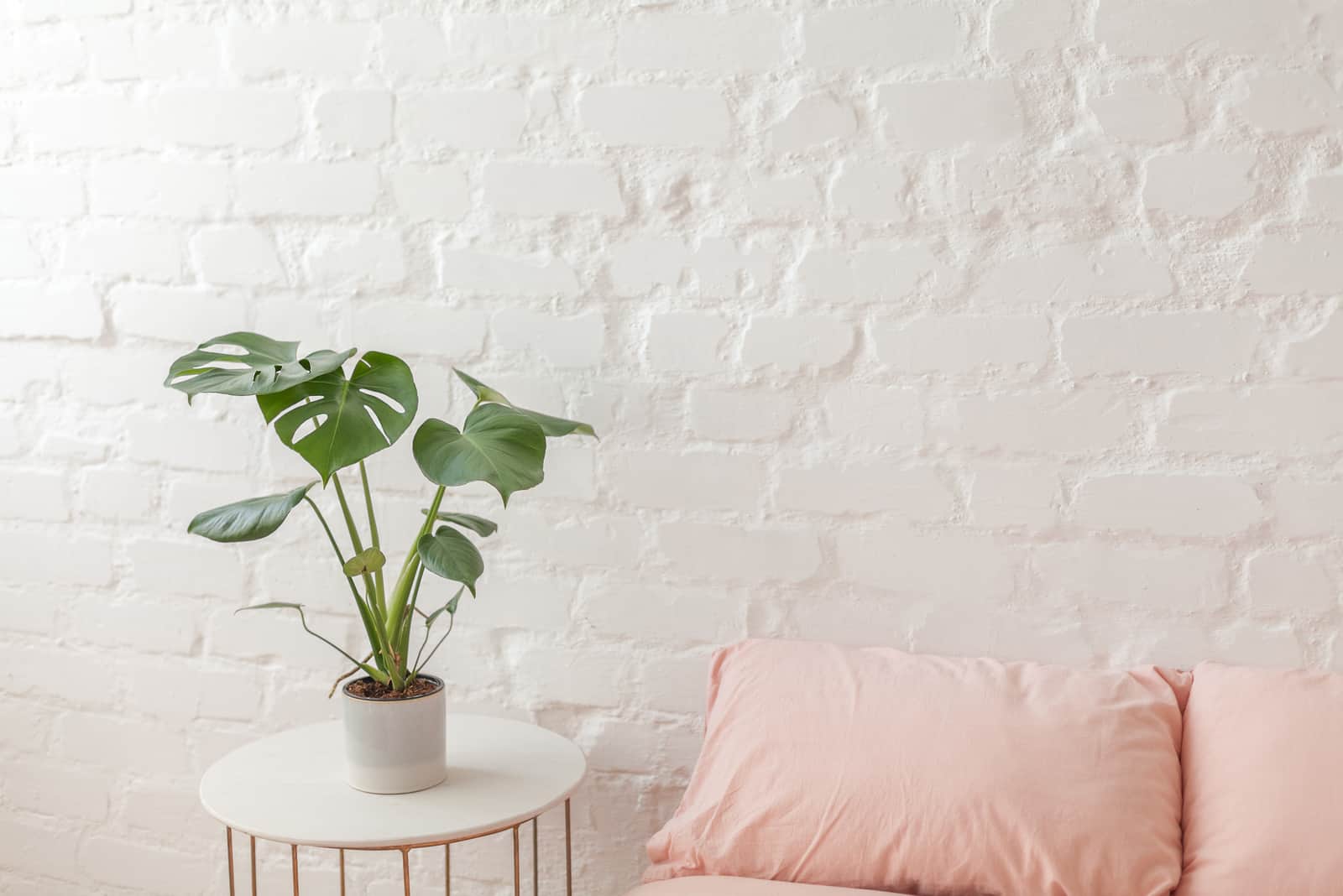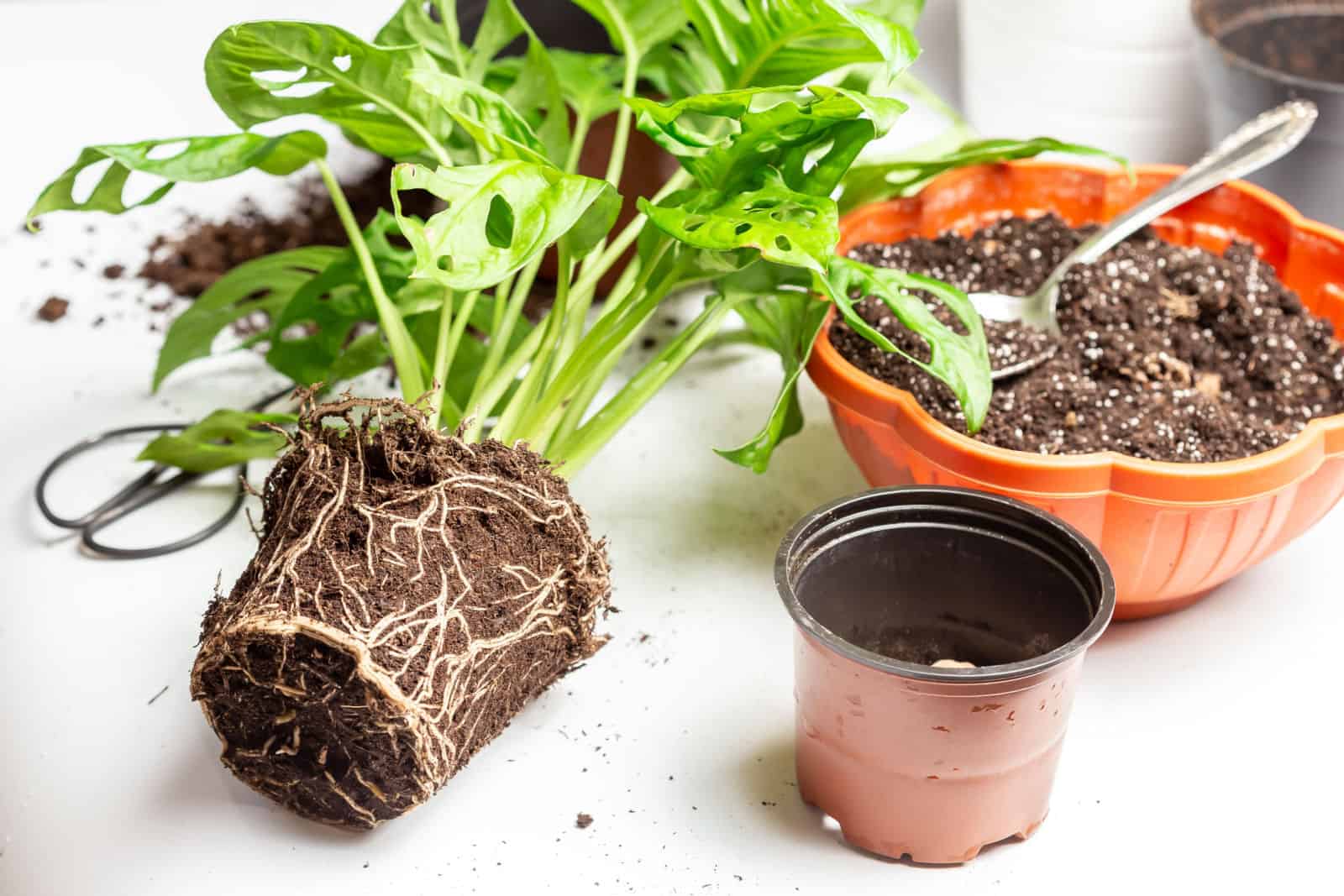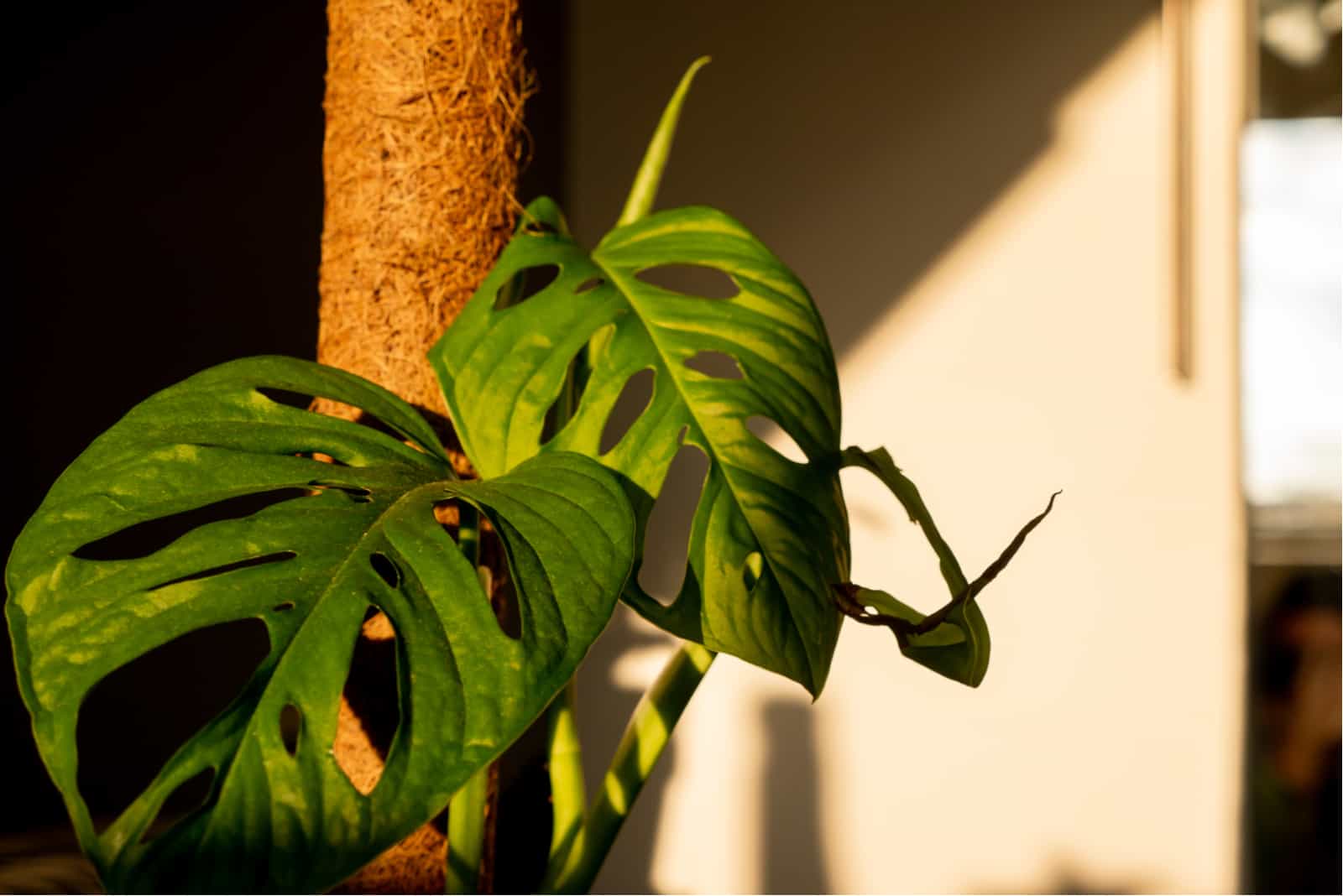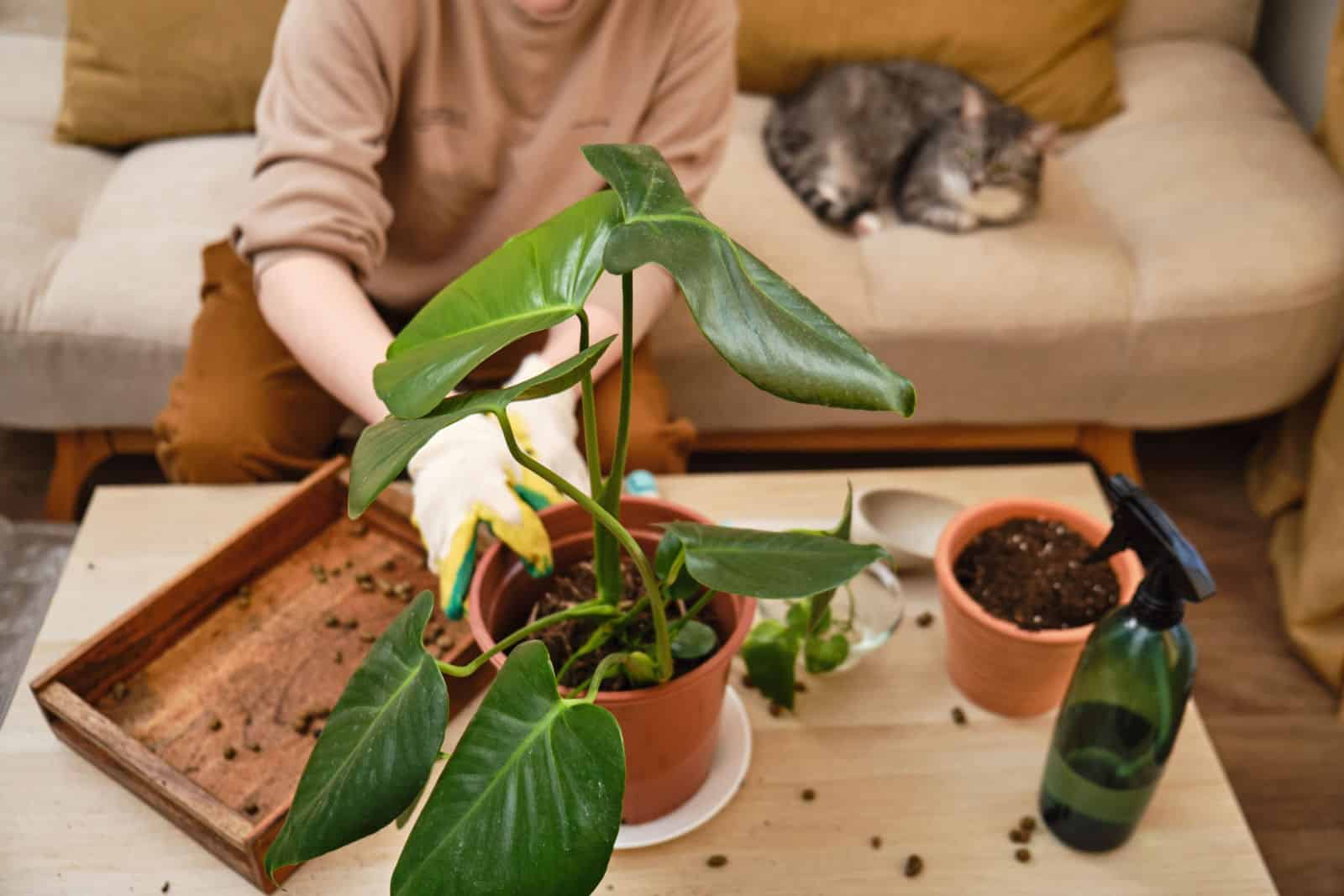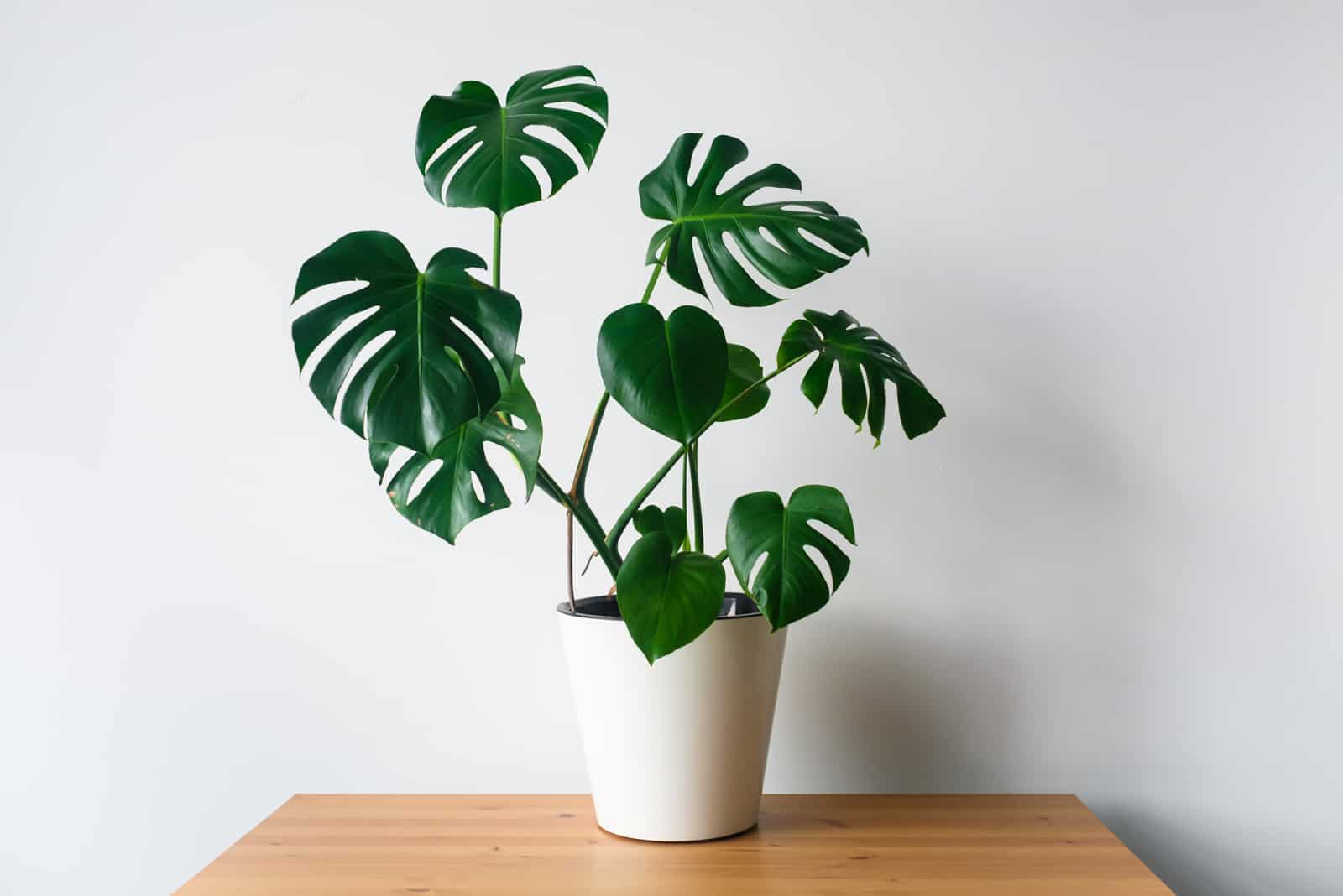Monsteras look breathtaking if provided with the right conditions. Even though their care requirements are simple, their health can significantly deteriorate if conditions aren’t kept in the optimal range.
Legginess isn’t uncommon in Monstera plants, and should be treated as soon as you notice it.
In this article, I’ll tell you more about the signs of a leggy Monstera and the most common causes of it. Of course, I’ll also show you how to address the issue and the best ways to prevent it.
Let’s get started!
What Does A Leggy Monstera Look Like?
It’s essential to discuss how to recognize legginess and differentiate it from normal growth. These plants are climbers and use tall trees as host plants in their natural habitat.
A healthy Monstera plant develops thick stems because the massive foliage of adult plants needs steady support.
Thin stems and smaller leaves are indicators of a leggy plant.
Additionally, the leaves will likewise be spaced wider apart. If you notice more stems than leaves, you’re dealing with a lanky plant.
Plants look really unhealthy and unattractive when they display leggy growth, so let’s see what causes this condition and, of course, how to fix it!
Why Is Your Monstera Leggy?
What makes plants become leggy anyway? Your Monstera will become leggy if it lacks light, grows in too small a pot, is overfed, or the temperatures are lower or higher than recommended.
Let’s get into details!
Low Light
Your Swiss cheese plant will be leggy if it’s growing in poor light conditions. Remember, these plants are native to tropical rainforests where they receive bright indirect light.
If provided with bright indirect light, your Monstera deliciosa will climb towards it. On the other hand, if light levels are too low, your plant will stretch out looking for a light source.
Your green buddy knows that light allows it to undertake photosynthesis, which produces nourishment for the entire plant.
You need to know that this plant species responds well to indirect light because it replicates the conditions found in the rainforest, in which it lives under a taller tree.
If given enough light, your Monstera is ready to climb.
If there is insufficient light, your Monstera will expand to locate a light source or some type of structure to climb upon.
As a result, the stems grow longer and become thinner; this is known as etiolation, and it is the most common cause of legginess.
Other Indicators Of Lack Of light In Monstera Plants
Legginess isn’t the only indicator that your plant isn’t getting enough light. It’s essential to know how to recognize lack of light in plants, as it may severely damage them and even cause death in extreme cases.
One of the signs that can help you determine if your Monstera adanosnii or deliciosa lacks light is leaf discoloration. The tips of the leaves will most likely turn yellow if they are not given enough light.
This could also signal that there are irrigation difficulties, which will require further diagnostics.
Additionally, plants often display poor growth due to lack of light, so if your fast-growing Monstera doesn’t grow any more, or at the usual speed, you might want to check the light level.
Legginess isn’t as dangerous as root rot, for instance, but as the time passes, your Monstera will look more and more stressed.
Container Size
Monsteras don’t like being rootbound, so they’ll display legginess if their roots don’t have enough space to spread.
If plants have overcrowded roots, they may have suffered irregular development patterns due to poor uptake of food and moisture
What happens here is that stronger roots kill weaker ones; this is very common if the Swiss cheese plant grows in too small a container.
Furthermore, when the roots occupy the majority of space inside a small container, the nutrient and moisture-retentive growing substrate is displaced.
If there isn’t enough substrate around the root system, they’ll lack the nutrients and water needed for further development.
Overfertilization
Growers sometimes make a huge mistake; they feed their plants more than the recommended amount to try and promote growth.
If you give your Monstera too much nitrogen-rich fertilizer, its growth rate will definitely increase. This often happens in the initial stages of a Monstera’s growth.
You will boost the growth and your Monstera generates cells quicker than normal if there is an excess of nutrients.
As a consequence, the stem is fragile and lengthy, making it susceptible to physical harm.
So, if you add too much fertilizer you’ll get a leggy plant; it will increase the growth rate, but will also significantly impact the plant’s overal health.
Incorrect Temperature
These plants are native to the tropics and they grow healthily in temperatures ranging from 68 to 86 degrees Fahrenheit.
If the temperature exceeds 86 degrees Fahrenheit, it will overheat.
Juvenile plants will experience growth spurts if they grow in higher-than-recommended temperatures.
Monstera stems will mostly likely lengthen if you don’t provide them with adequate support. To avoid etiolation, Swiss cheese plants enter the hibernation period during colder months.
This is a sort of defense mechanism; I mean, the Monstera is a smart cookie and understands days are shorter and light exposure is significantly lower during the winter.
As soon as temperatures drop, your Monstera will enter the hibernation stage.
If the temperatures are incorrect, you’ll end up with a leggy plant.
How To Fix A Leggy Monstera Plant
If your Monstera is leggy and you’ve determined the cause, it’s time to solve the issue.
Pruning
The best way to fix a leggy Monstera is to prune abnormal growth. This may appear frightening, especially to beginner growers, but the procedure is actually quite straightforward.
The best time to prune your Monstera is at the beginning of spring or summer as your plant is entering the growing season.
This guarantees that your Monstera has adequate energy to quickly mend any cuts, which helps avoid infections or pest infestations.
Enough talk, let’s prune!
How To Prune A Leggy Monstera
The first step is to prepare the tools you’ll use for trimming your Monstera. You’ll need a pair of sharp shears/pruners, as well as a sanitizing agent. Rubbing alcohol or diluted bleach are my favorite options.
Your tools are ready, so pruning can begin.
Here’s the procedure:
1. Determine which portions of your Monstera plant need to be pruned. Any weak or abnormal growth can be removed. Plan ahead of time to avoid becoming stressed (it’s happened to me more than once).
2. Find the node on the portion you selected and make an incision at a slight angle, taking special care not to cut the primary stem, which might result in illnesses that injure the plant.
Note: Wear gloves when handling Monstera adansonii plants or any other Monstera species. These plants produce a substance known as calcium oxalate, which may cause skin irritation. If you don’t like gloves, wash your hands after you are done pruning.
Ensure Enough Light
Since poor light is the main cause of legginess in a Monstera deliciosa or any other species, you need to adjust the light levels.
Your Monstera generates fenestrations, and you can encourage more fenestrations by ensuring it gets enough light.
As you solve the legginess issue, you will also stimulate your plant to develop the stunning foliage patterns that all Monstera enthusiasts desire.
Windows with southern or eastern exposure work perfectly for Monsteras.
The main thing to pay attention to is not to let direct sunlight reach the Monstera leaves; this can result in severe sunburns and more unnecessary issues.
Pro tip: Protect Monstera foliage from direct sunlight by placing sheer curtains on the windows!
I prefer to measure things rather than rely on intuition, so I recommend purchasing a light meter. Many high-quality and accurate light meters are available in plant stores or online.
200-500 foot candles is the optimal range for Swiss cheese plants.
Rotate Your Monstera
A common problem with plants and light is that one side of the plant gets sufficient light while the other doesn’t receive enough.
Luckily, there’s a simple solution to this problem. By rotating our plants, we ensure that each side of the plant receives enough sunlight to grow healthily.
Use Artificial Lights
If you’re afraid that you can’t provide your Monstera with enough sunlight, then consider purchasing artificial lights.
These devices come in numerous sizes and have many different options; choose one that you can afford. Each will work well when used properly.
The most crucial aspect to consider is the number of lumens required. I recommend artificial lights with at least 1600 lumens.
The leaves will develop best if you provide blue light. It is strongly related to the production of chlorophyll, which results in robust, healthy stems and foliage.
If you don’t want to spend a lot of money on these devices, then go with LED bulbs.
Clean The Foliage
This might disappoint you, but cleaning is also a part of Monstera plant care. Of course, this refers to cleaning the foliage.
What happens is that dust on the leaves (if any) prevents the leaves receiving enough sunlight for photosynthesis.
Just wipe the foliage from time to time to allow the light to reach the leaf surface.
Use A Suitable Container
We’ve seen that the size of the container can cause Monsteras to become rootbound, which results in legginess.
It may be pretty tricky to determine if your plant is rootbound, as leggy growth is above the soil surface and we don’t really know what’s going on underneath.
If your Monstera is leggy, you might want to check if the roots are poking through the drainage holes in the bottom of the container.
If so, your Monstera needs to come out of its pot and be transferred to a larger one. When choosing a new container for your Monstera, go with an inch or two larger than the current one.
Let’s learn how to transfer a Monstera to a larger container, i.e., repot it!
Repot Your Monstera
Before you start repotting your Monstera plant, you need to prepare a suitable growing substrate.
Use a substrate that has been supplemented with materials such as coco coir, vermiculite, peat moss, perlite, pumice, and orchid bark.
If you use these materials, you’ll prevent excess water accumulation, ensure better air circulation, and aid in moisture retention.
The benefit of repotting isn’t only solving the root bound issue, but also ensuring new nutrients that will encourage further growth.
Be careful when taking your Monstera deliciosa or any other species from the pot; never pull the plant as you can severely damage it.
Tilt the container to one side and let your plant slide out; if you grow large specimens, you should ask for help.
Loosen the substrate around the roots and check if all roots are healthy; transfer your plant to a new pot filled with adequate soil for Monsteras, and irrigate well.
Train Your Monstera To Climb
One of the best ways to prevent and save your Monstera from legginess is by training it to climb.
What does this mean? Well, if you attach your plant to some type of structural support, such as a moss pole or trellis, the foliage will receive enough light and won’t stretch toward the light source.
Another benefit of installing moss poles or trellises is that plants look prettier because you can control their shape, and the vines don’t spread everywhere.
Your plant will look more compact, so you don’t need to trim its lovely foliage.
Additionally, your Monstera will have enough air, which will result in healthier growth and less infections.
Adjust Temperature
We’ve seen that Monsteras grow faster and become leggy if they don’t hibernate. To induce hibernation, move your Monstera to a room with lower temperatures (not too low).
Pay attention to light levels; the best idea would be to transfer your Monstera to a cooler room with southern or eastern exposure.
Your plant will have enough light during the colder months, and cooler temperatures help the plant go through dormancy.
There’s also one more thing to remember: Monsteras can’t withstand sudden temperature changes, so it’s best to keep them away from radiators, fireplaces, and heating vents. The same goes for cold drafts; never put your Monstera near drafty windows or air conditioners!
Change Fertilizing Schedule
Yes, overfeeding leads to legginess, but you can’t really stop feeding your Monstera. These are fast-growing plants, which means they use all the nutrients from the growing substrate quickly.
You just need to change the frequency and type of fertilizer you use.
How often should you fertilize Swiss cheese plants? Well, only during the active growth, i.e., the growing season, which takes place from spring through summer.
The best food for these plants is balanced, all-purpose, diluted fertilizer. You can feed your adansonii or deliciosa once a month during the warmer months, and pause during winter.
You can also go with organic fertilizers; Monsteras seem to love worm castings. This will be considerably closer to what the Monstera plant would obtain outside in its native habitat.
The application of compost isn’t rocket science; you simply put a layer of compost (half an inch) on the topsoil and work it in with a small garden shovel or your fingers.
Make sure you irrigate well after adding compost.
Don’t Forget To Propagate
If you have pruned your Monstera, don’t discard the healthy sections of the plant. Take the cuttings with nodes and use them for propagation.
Prepare a jar and fill it with clean water (water propagation) or add a growing substrate to a nursery pot (soil propagation).
Place the cutting in a jar, leaving the foliage above the water line; it will rot if left in water. I recommend refreshing the water on a weekly basis. Transplant the cuttings in the growing substrate as soon as you notice the roots.
If you are rooting directly in the substrate, apply rooting powder to the cut end and put it in the substrate. Mist it regularly and transplant it when new roots occur.
Wrapping Up
Unhappy plant=unhappy grower! There isn’t much to tell about a Monstera’s appearance; I mean, just look at it! No wonder it’s a part of almost every plant collection.
Of course, the plant will be happy if it grows in the correct conditions. If you have a leggy Monstera, trust me, I know how you are feeling.
Low light causes big problems in all plant species. Even though Monsteras tolerate lower light better than other common houseplants, they still need light for growth.
Pay attention to pot size now that you know how overcrowded roots affect plant’s appearance and health. Don’t feed your Monstera too often (I know, you only want the best for your plant). Finally, make sure the temperatures are proper so as to avoid legginess and other issues.
If you follow our advice, I’m sure you’ll successfully solve the problem with legginess and also avoid it in the future.
Until next time!

